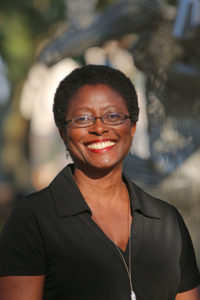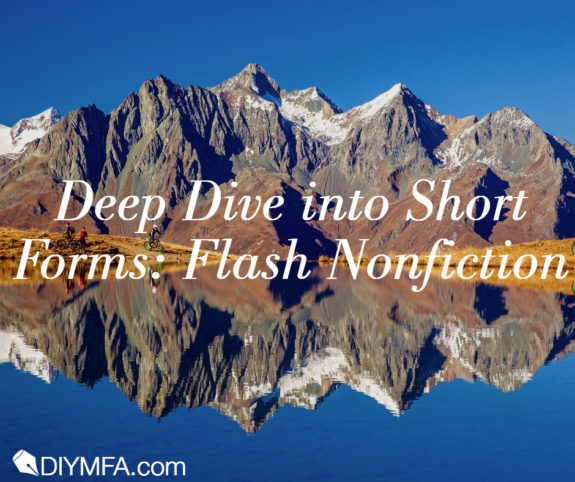It’s fitting, as a poet, that my first published foray into fiction, Let It Go, was a piece of flash fiction. The story clocked in at a brief 286 words.
Brevity is the bedrock of writing flash. I consider flash writing forms as cousins to poetry. Grant Faulkner, the editor of the literary magazine 100 Word Story, describes flash similarly: “I think of flash fiction as being one part story, one part poem.” Flash shares the same mandate as poetry—brevity and distillation. Like poetry, every word counts. Its collective hybrid forms rely on the importance of description carefully chosen to evoke character, setting, time and place.
To understand the literary hydra that is flash, let’s dip into its many faces, names, and word counts. Generally, flash encompasses both fiction and nonfiction. It straddles the line between poetry and longer fiction. Between poetry and long-form creative nonfiction.
The term “flash” refers to the form’s length, which can vary anywhere from six to 2,000 words. Most published flash falls between 300 to 1,000 words. Flash nonfiction, specifically, usually runs between 500 to 1,000 words.
Flash fiction goes by multiple names—microfiction, short-shorts, quick fiction, immediate fiction, and sudden fiction—and rambles through a variety of genres. Flash nonfiction focuses on memoir, essay, and factual writing. It’s also called by more than one name, such as micro essay, flash creative nonfiction, and flash memoir.
At this point, you’re probably expecting me to discuss boring specificities like point-of-view requirements—first person, second person, or third person omniscient. Not so much. Although flash nonfiction is all about the facts, there’s more to it than that. That’s what makes flash nonfiction so exciting.
We read fiction to be transported; we read nonfiction to be amazed. After all, what’s more astonishing than life? The only specificity about flash nonfiction is writing what’s true, writing what’s factual, while using fiction-writing techniques and a poet’s sensibility. Telling the truth with flair.
Where There’s Flash, There’s Flair
A single theme, metaphor, or decisive action becomes the lens a poet uses to lead readers into their poem. In Niya Marie’s The Black Hairstory Lesson, I’m reminded how true that is, too, for flash nonfiction. She uses the ritual of haircare and its place in Black culture as the lens to tell her history or hairstory. In a mere 715 words, she unspools beauty shop culture, pop culture, and her evolving sense of self.
She begins sometime between “the year micro-braided, brokenhearted girls sang Ashanti” and “the year triple-X-tee’d boys-will-be-boys broke down the name of Osama bin Laden”. Her hairstory frames the relationship with her first and last boyfriend and her personal evolution.
Let’s read:
“He was City Blue down to the socks. Cords of muscle coiled like concertina wire under his brick-brown skin. Irises like dollops of burnt sugar would melt the size-2 Baby Phat right off my peekaboo hips. Whenever his mother worked a double at the hospital, I’d be in her kitchen baking brownies in nothing but a wife beater, just to show her son I could be that girl, his girl, the girl latched onto a boy’s hip as if she’d sprung from it. I wasn’t his first, but I was determined to be his last. I kept my straightened hair shiny as a new penny and swooped it over my left eye like Aaliyah. I got a touch-up every six weeks to mirror the girls who’d come before me and keep pace with the ever eager next-ups.”
That short passage crackles with imagery and is full of detail: City Blue, Baby Phat, Aaliyah, straightened hair and a touch-up. All chosen to best set the scene of urban African-American teens.
For me, Marie’s words sing most true when she describes the transformation of her hair into an artificial sleekness:
“The point of her rattail comb would needle my scalp as she cleaved through sheaves of my blown out hair. I inhaled a flurry of scents: the hair care aisle’s ethnic section uncorked; baby powder, Muslim smell-goods; the bitterness of he-ain’t-shit blues, the sweetness of he-put-it-down arias; smoking metal heated just shy of incandescence; and the lingering pungency of relaxer.”
“Once pleased with the geometry of her parts, Ms. Jackie would relieve the stove of its iron. I’d hear the clink-clink-clank of catch and release, and feel her cooling breath chasing the blackened barrel down the length of my hair. After an hour or three, my strands—lovingly cooked into submission—would cascade over my shoulders like chiffon.”
Marie highlights a unique slice of Black hair culture and, at the same time, evokes a universal moment of female beauty culture.
Freedom Without, Freedom Within
Flash’s allure is in its brevity and utter openness to other genres. Poets and fiction writers can easily transfer their skills to this different but related form. This makes Marie’s deft use of language—her word choice and its musicality—understandable. About her work overall, she says: “I fancied myself a fiction writer until I encountered a genre-queer called creative nonfiction.”
In The Rose Metal Press Field Guide to Writing Flash Nonfiction, Dinty W. Moore instructs writers on creating their own pieces:
“The brief essay, in other words, needs to be hot from the first sentence, and the heat must remain the entire time. My fire metaphor […] does not refer to incendiary subject matter. The heat might come from language, from image, from voice or point-of-view, from revelation or suspense, but there must always be a burning urgency of some sort, translated through each sentence, starting with the first.”
Resources
If flash nonfiction is new to you, I suggest reading the following books and magazines to get started:
- Brevity Magazine — Dinty W. Moore, editor
- Creative Nonfiction Magazine — Lee Gutkind, editor
- Keep It Real: Everything You Need to Know About Researching and Writing Creative Nonfiction — Lee Gutkind, editor
- 100 Word Story Magazine — Grant Faulkner, editor
- The Rose Metal Press Field Guide to Writing Flash Nonfiction — Dinty W. Moore, editor

Brenda Joyce Patterson is a poet, writer, librarian, and lover of short writing forms. Her poetry and flash fiction have been published in Vayavya, Gravel Magazine, and Melancholy Hyperbole. Along with works by Maya Angelou, Gwendolyn Brooks, and Alice Walker, her travel essay “The Kindness of Strangers” appeared in Go Girl: The Black Woman’s Guide to Travel and Adventure.







